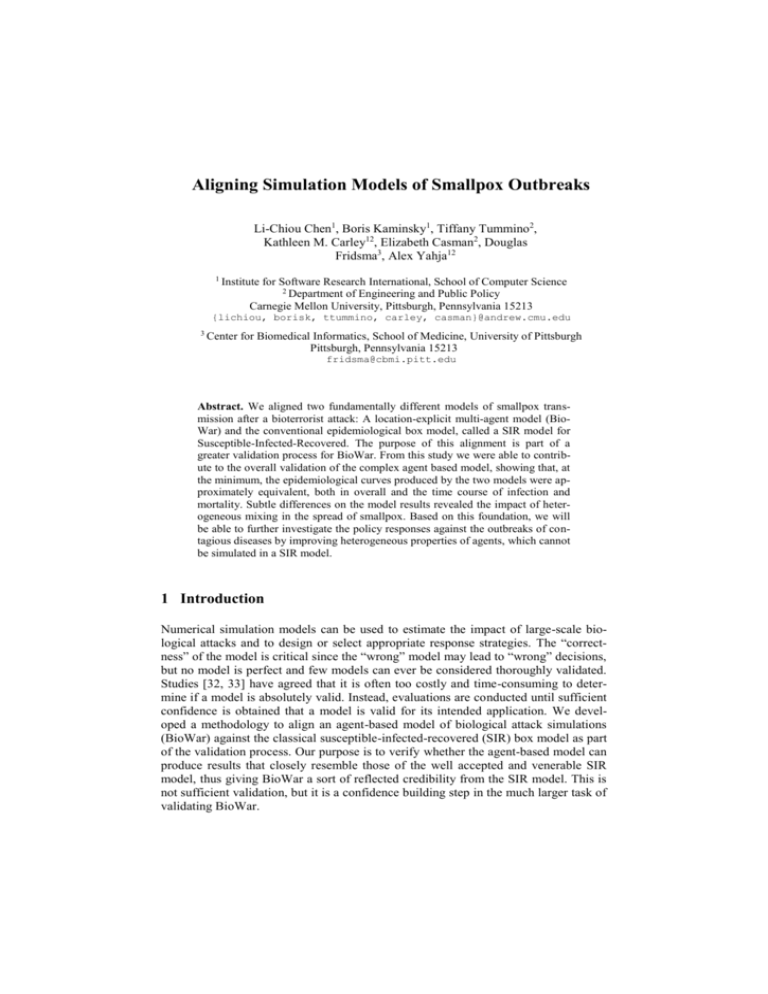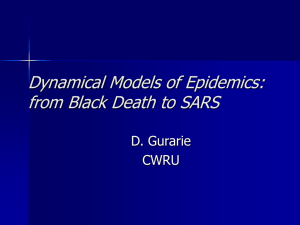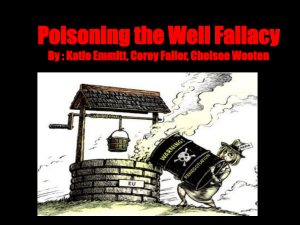Aligning Simulation Models of Smallpox Outbreaks
advertisement

Aligning Simulation Models of Smallpox Outbreaks
Li-Chiou Chen1, Boris Kaminsky1, Tiffany Tummino2,
Kathleen M. Carley12, Elizabeth Casman2, Douglas
Fridsma3, Alex Yahja12
1 Institute
for Software Research International, School of Computer Science
2 Department of Engineering and Public Policy
Carnegie Mellon University, Pittsburgh, Pennsylvania 15213
{lichiou, borisk, ttummino, carley, casman}@andrew.cmu.edu
3 Center
for Biomedical Informatics, School of Medicine, University of Pittsburgh
Pittsburgh, Pennsylvania 15213
fridsma@cbmi.pitt.edu
Abstract. We aligned two fundamentally different models of smallpox transmission after a bioterrorist attack: A location-explicit multi-agent model (BioWar) and the conventional epidemiological box model, called a SIR model for
Susceptible-Infected-Recovered. The purpose of this alignment is part of a
greater validation process for BioWar. From this study we were able to contribute to the overall validation of the complex agent based model, showing that, at
the minimum, the epidemiological curves produced by the two models were approximately equivalent, both in overall and the time course of infection and
mortality. Subtle differences on the model results revealed the impact of heterogeneous mixing in the spread of smallpox. Based on this foundation, we will
be able to further investigate the policy responses against the outbreaks of contagious diseases by improving heterogeneous properties of agents, which cannot
be simulated in a SIR model.
1 Introduction
Numerical simulation models can be used to estimate the impact of large-scale biological attacks and to design or select appropriate response strategies. The “correctness” of the model is critical since the “wrong” model may lead to “wrong” decisions,
but no model is perfect and few models can ever be considered thoroughly validated.
Studies [32, 33] have agreed that it is often too costly and time-consuming to determine if a model is absolutely valid. Instead, evaluations are conducted until sufficient
confidence is obtained that a model is valid for its intended application. We developed a methodology to align an agent-based model of biological attack simulations
(BioWar) against the classical susceptible-infected-recovered (SIR) box model as part
of the validation process. Our purpose is to verify whether the agent-based model can
produce results that closely resemble those of the well accepted and venerable SIR
model, thus giving BioWar a sort of reflected credibility from the SIR model. This is
not sufficient validation, but it is a confidence building step in the much larger task of
validating BioWar.
Aligning the two types of model is challenging because of their radically different
structures. We demonstrate an objective methodology for translating key parameters
between models, for running the models in concert to supply aligned inputs during
simulations, and for evaluating the agreement between the models.
BioWar is a multi-agent simulation tool of biological attacks. It combines computational models of social networks, disease models, demographically resolved agent
models, spatial models, wind dispersion models, and a diagnostic model into a single
integrated system that can simulate the impact of a bioterrorist attack on any city [7].
For this paper, we restrict the alignment to the smallpox simulation in BioWar. The
SIR model and its variations have been widely used to model the spread of epidemics
and to study immunization strategies [1, 2, 4, 13]. The SIR model is a “populationbased” aggregated representation of disease transmission that assumes homogeneous
mixing of individuals. In contrast, BioWar models the complex social interactions and
heterogeneity of mixing absent in most SIR models.
Model alignment, also referred to as “docking,” is the comparison of two computational models to see if they can produce equivalent results. Properly done, model
alignment can uncover the differences and similarities between models and reveal the
relationships between the different models’ parameters, structures, and assumptions.
The purpose of aligning BioWar with the conventional box model is to demonstrate a
general equivalence, as part of a greater validation process for BioWar. The concept
of model alignment was first proposed by Axtell et al. [3]. We have used this method
previously in validating BioWar’s anthrax simulation [10].
This paper is organized as follows. The next section provides background information on smallpox and the two models. Section 3 explains our methodology of model alignment. Section 4 discusses our findings and compares the two models based on
the simulation results. Conclusions and discussion of future work follow.
2 Two models of smallpox transmission
Smallpox has several distinct stages, including incubation, prodrome (earlysymptoms), and fulminant (late-symptoms). The initial site of viral entry is usually
the mucous membranes of the upper respiratory tract. Once a person is infected, the
incubation stage usually lasts for about 12 to 14 days. During this period, an infected
person experiences no symptoms and is not contagious. The first symptoms of disease
include fever (typically high), head and body aches, and possibly vomiting. This prodromal stage lasts about 2 to 4 days. During this time infected persons are usually too
sick for normal activity, and may be contagious, although infectivity is often negligible [14].
The fulminant stage begins with the onset of rash. The rash appears first on the
tongue and inside the throat or mouth, then appears on the face and limbs, usually
spreading across the body within 24 hours. An infected person is most contagious
within the first 7 to 10 days after the dermal rash appears. The rashes become bumps
on about the 3rd day of the fulminant phase. The pox fill with liquid and acquire a distinctive shape with a depression in the middle by the 4th day of the period. Most
smallpox deaths occur on the 5th or 6th day after the onset of rash [27, 23, 35]. Over a
period of about 5 days after the pox fill with liquid, they become firm, sharply raised
pustules; over another 5 days, these pustules crust and scab. Within about 14 days of
the appearance of the rash, most of the pustules will have formed scabs. Within about
3 weeks after the onset of the rash, all of the scabs fall off, though the scab material is
infectious somewhat longer.
Transmission of smallpox from an infected person to an uninfected person usually
requires face-to-face personal contact, inhalation of droplets formed by coughing or
sneezing, or contact with infected body fluids or contaminated objects (e.g., bedding)
[8]. While infection has occurred through the spread of the virus through the air in
buildings or other enclosed areas, this type of transmission has been rare. Humans are
the only known reservoir of the virus, and there has been no known transmission via
animals or insects.
D
S
I
P
C
a1
Q
R
a2
Fig 1a. An illustration of the SIR model. Individuals (represented as dots) in a state have the
transition probability of moving to next state
D
S
a1
I
P
C
Q
R
a2
Fig 1b. An illustration of the disease transmission process in BioWar. Each individual (such as
a1) has its own state machine and has a different reproductive rate (e.g. a1 infects one case but
a2 infects 3 cases)
Two types of models have been used to study the progression of smallpox outbreaks.
They are population-level box models [6, 17, 24, 26] and individual-level agent-based
models [19]. These population-level models are either variations or stochastic versions of the basic SIR model. The SIR model [1, 2] is a widely used model of the
spread of a disease through a population. As noted, the SIR model describes the epidemic diffusion process by categorizing the entire population into three states – susceptible, infectious and recovered – linked by differential equations. The SIR model
assumes that the population is homogenous and completely mixed. All members of a
particular state are identical and have predefined transition probabilities of moving to
another state in the model (Fig. 1a).
In contrast, agent-based models assume a heterogonous population with mixing only within socially defined networks (Fig. 1b). BioWar models the residents of a city
(agents) as they go about their lives. When a bioattack occurs, those in the vicinity of
the release may become infected, following probabilistic rules based on received dose
and age of the agent. The infected agents modify their behaviors as their disease progresses and they become unable to perform their normal functions. Susceptible agents
are infected if they come within a certain distance with infectious agents following
probabilistic rules concerning the likelihood of infection. BioWar is not just an agentbased model, but a network model where the networks vary dynamically based on
agent activity. Agents interact within and through their social network which is based
on their age, race, gender, socio-economic status, and job. Consequently, which
agents are likely to be infected and to infect others, depends on things like time of
day, location of attack, time of year, age of the agent, and so on. Unlike many other
agent-based models, BioWar is tightly coupled to demographic, school, economic,
and social data as well as physiological, disease, geographic, weather, and climate data. The fine grained detail by which heterogeneity is defined, and the level of detail in
agents behaviors (e.g., they don't just get infected and die, they go to the hospital, to
the doctor, to the pharmacy, and so on) means that BioWar, unlike SIR models, can
be used to examine response behavior far beyond mortality indicies. A detailed description of the BioWar model is published in [7].
The mathematical equations of the modified SIR model used in this paper follow.
This modified SIR model allows us to simulate the residual immunity in the population and vaccination or patient-isolation response strategies. As in (1), the total population N is divided into seven states: susceptible (S), incubation: infected but not yet
infectious (I), prodrome: infected with non-specific symptoms (P), contagious with
specific symptoms but not yet quarantined (C), contagious with specific symptoms
but quarantined (Q), population that die (D), and population that recover and become
immune (R).
(1)
N= S+ I+ P+ C+ Q+ D+ R.
Transition probabilities, , , , , , are the rates that the population changes from
one state to another state, and is the death rate.
We revised the original SIR model to cover different population groups so that it
can be used to model residual immunity and vaccination. Let g represent the number
of population groups. For example, g =1when the entire population is homogeneous
as in our base scenario and g = 3 when we separate the population into three groups
(no vaccination, residual immunity, vaccinated) as in our vaccination scenario. In this
case, the population in each state is divided into these groups and the total population
g
N is equal to
N
i 1
i
. Each group has its own transition probability of reproduction
and death rate. We assume that the disease-stage durations are the same across
groups. Thus, transition probabilities, , , , are the same for each group. The differential equations of the SIR model are as (2) and (3).
dSi
dIi
dPi
i Si C ,
i Si C I i ,
I i Pi ,
dt
dt
dt
dQi
dDi
dRi
Ci Qi ,
iQi ,
(1 i )Qi .
dt
dt
dt
dS
dt
dQ
dt
g
dS i
,
dt
dI
dt
dQ
,
dt
dD
dt
i 1
g
i 1
g
dI i
,
dt
dDi
,
dt
i 1
g
i 1
dP
dt
g
i 1
g
dR
dt
dPi
,
dt
i 1
dCi
Pi Ci ,
dt
dC
dt
g
i 1
(2)
dCi
,
dt
(3)
dRi
.
dt
3 Model Alignment
We first aligned the input parameters (Section 3.1) of the two models by calculating
the reproductive rates from BioWar experiments (Section 3.2). We then designed scenarios to simulate smallpox outbreaks using the two models (Section 3.3), and compared population level results (Section 4). Fig. 2 illustrates our alignment methodology.
Parameter Alignment
Determine mean, standard deviation,
and probability distribution for
durations of each disease stage
probability
distributions
death rates,
infectivity
disease durations
Review literature for disease
durations, death rate, and
infectivity in historical cases
initial infections, reproductive rate (R)
Run BioWar model
Run SIR model
Develop simulation scenarios
Simulations
disease
durations
death rates, average
disease durations
cumulative infections, cumulative deaths
Test that the disease durations
from BioWar are gamma
distributed
Results Comparison
Fig 2. The process of model alignment
Test that the equality exists between
BioWar and from SIR in the patterns
of infections and mortality over time
3.1 Parameter Alignment
Although BioWar and SIR use are structurally very different, some of their model parameters are related. The parameter alignment process helped us to tune BioWar parameters to current epidemiology studies and to compare these parameters with those
in the SIR model.
Both BioWar and SIR simulate disease progression in terms of the transition of infected individuals between disease stages, but with different stochastic framing. BioWar utilizes probability distributions to determine the duration of each disease stage
for each infected agent. Based on statistical analyses of several empirical data sets
[14], we model smallpox stage durations as gamma distributed with a mean
standard deviation [12, 14-15, 18, 20]Table 1 lists the values of
for the
disease stages (incubation (I), prodrome (P), and fulminant. The fulminant stage is divided into fulminant-contagious (C) stage and fulminant-quarantined (Q)). In contrast,
SIR uses transition probabilities to represent the rates sectors of a population move
from one state to another. To align the SIR model with BioWar, we set the transition
probabilities1 to ()-1. Table 2 shows this parameterization for the SIR model based on
the mean disease-stage durations from BioWar. Although we can conduct Monte Carlo simulations of the SIR model treating as a random variable of gamma distribution, the stochasticity is different from that in BioWar. In BioWar the gamma distribution describes the variation among individuals and in the SIR model it describes the
variation around the population sector mean.
Table 1. Means and standard deviations for disease-stage durations of smallpox
incubation
prodromal
fulminant
contagious
(without quarantine)
contagious
(with quarantine)
State in SIR
model
Mean
(in days
Standard deviation
(in days
I
P
C and Q
C
11.6
2.49
16
7
1.9
0.88
2.83
2.83
C
2
1
Table 2. Transition probabilities of the SIR model
Name of transition probability
Leaving incubation ( )
Leaving prodromal (
Leaving contagious (
Leaving quarantine (
1
Transition probability (in [0,1])
1/11.6
1/2.49
1/7 (without quarantine), ½ (quarantine)
1/16
In a Markov model, the transition probability from one state to another state is estimated by
the inverse of the expected continuous duration of that state [21].
The disease transmission in the two models is also different stochastically. In BioWar,
at a certain probability (infectivity), an infectious individual will infect other individuals whose physical distance is less than 100 meters from the infectious individual.
As a result, the disease transmission probability (the number of new infections at a
certain time) is determined by social factors influencing the interactions among
agents, such as infectivity, social networks and their daily activities. In contrast, in
SIR the disease transmission probability is equal to a transition probability of reproduction () multiplied by the number of susceptible people plus the number of infectious people in the population. This transition probability is constant across the entire
course of a simulation but the transmission probability is not.
Although we cannot align the two models stochastically, we can align the models
at the same average level of disease transmission probability by using reproductive
rates and the number of initial infections. Since BioWar can simulate the interactions
among agents, reproductive rates are emergent properties (outputs) from simulations.
Similarly, the number of initial infections is also an emergent property since BioWar
can roughly estimate it from information about the location of an attack, the released
amount of smallpox viruses, and the daily activities of the agents. In contrast, the SIR
model cannot simulate the interactions so that it needs to determine and the number
of initial infections before running the simulations. We experimentally derived both
from BioWar experiments.
3.2 Deriving Reproductive Rates from BioWar Experiments
The reproductive rate R is defined as the expected number of secondary cases produced by an infectious individual in a population of S susceptible individuals. The
basic reproductive rate R0 represents the value of R in a totally susceptible population
N. When the natural birth rate and death rate are negligible compared to the transition
S
probabilities, the expected reproduction rate R can be approximated as
and R0 is
approximated as
N
[1].
Based on the above definitions by Anderson and May, we experimentally calculated
R
R0 from BioWar outputs using equation (4). In this case, we can estimate 0 .
N
This method of deriving R0 has been used in another agent based simulation [14].
R0
the number of secondary cases infected by initial infections
the number of initial infections
.
(4)
Alternatively, we can also derive from BioWar directly. The number of new infections at certain time is equivalent to SC in the SIR model in which S represents susceptible individuals and C represents contagious population. Thus, at time t can be
approximated by (5).
(t )
new infections (t)
.
susceptible (t) * contagious (t)
(5)
Since BioWar is an agent based model, unlike SIR, the estimated transition probability is not a constant. In order to compare the average case in BioWar with SIR, we
calculated E( ) as the average of across time when it is larger than 0 ( means no
new infections at the time). We can then estimate R as (6).
R
E ( )S
.
(6)
3.3 Simulations
To compare the population level results from both BioWar and SIR, we simulated
three smallpox attack scenarios: “base”, “vaccination”, and “quarantine”. We started
with a simplified base scenario and varied some of the parameters in other scenarios
to increase the fidelity of the simulation. Table 3 lists the definitions of the three scenarios. For each scenario, we present the results as averages of 100 runs because the
fluctuation of disease reproductive rates is negligible in around 100 runs.
We simulate an attack on the Washington, DC area, scaled down to 10% of its
original size to speed up our simulations. The total population after scaling was about
55,900. In the base scenario we assume the attack goes undetected and no public
health responses or warnings occur after the attack. We assume that infected individuals are not contagious when they are in early-symptomatic stage because infectivity in
this stage is considered to be negligible relative to the infectivity of later stages [14,
15]. All individuals in the city are assumed to be completely susceptible to smallpox
in the base scenario.
Table 3. Simulation scenarios
Scenarios
base
vaccination
quarantine
Residual immunity
(% of total population)
0%
46%
46%
Fresh vaccination
(% of total population)
0%
50%
0%
Is infected population quarantined?
no
no
yes (on average, 2
day after the onset
of rash)
We modeled an indoor smallpox attack where a random number of agents (less than
10) are initially infected. For the second and third scenario, we categorized the population based on their immunity: residual immunity, fresh vaccination, and no vaccina-
tion. Agents with “residual immunity”2 are assumed to have been vaccinated 30 or
more years previously and their immunity against smallpox has weakened. In the US,
90% of the people born before 1972 were vaccinated, so about 50% of the contemporary population should have some level of the residual immunity [17]. In the scaled
down DC population, approximately 46% (25,653 out of 55,930 people) were assigned residual immunity. Agents with “fresh vaccination” are assumed to have been
vaccinated around two months before the attack. These individuals have high (but not
perfect) immunity against smallpox. “No vaccination” means that the individuals had
never been vaccinated. Table 4 lists the assumed probability of death following infection and infectivity for each of the three immune status categories [5, 9, 20].
Both “vaccination” and “quarantine” scenarios consider the residual immunity of
the population. In addition, the “vaccination” scenario examines the effects of fresh
vaccination among the population and the “quarantine” scenario examines the effects
of infectious individuals being quarantined in around 2 days after the onset of rash so
they will not infect other agents. In the “vaccination” scenario, agents are randomly
selected for vaccination and agents who had been vaccinated before 1972 may be
vaccinated again.
Table 4. Simulation parameters for different population categories
Infectivity
Probability of death following infection
Residual immunity
50%
7%
Fresh vaccination
5%
2%
No vaccination
95%
30%
4 Results and Discussion
We conducted both qualitative graph comparisons and statistical tests on the population level results. For each set of results from BioWar and SIR, we first compared
them graphically and then statistically. For the disease-stage durations, we conducted
parametric chi-square (X2) tests to see if BioWar results are gamma distributed. To
compare the rate of transmission and mortality from smallpox over time, we used
non-parametric two sample hypothesis tests to compare the data generated by the two
models.
4.1 Disease-Stage Durations
BioWar smallpox stage (incubation, prodrome, fulminant) durations are modeled as
gamma distributed while SIR disease-stage durations are the average case of the
gamma distributions. The average of the individual stage durations generated by
2
Here we refer to individuals who were vaccinated many years ago in contrast with fresh vaccination. However, this term is usually used to describe all individuals who have been vaccinated.
BioWar should be close to the durations the infected population spends in each disease-stage in SIR. To verify this, we tested if the BioWar disease-stage durations are
actually gamma distributed. The point of testing is simply to verify that BioWar is doing what it is told to do. In agent-based simulations, this should not be taken for
granted.
We calculated the three disease-stage durations for 1000 infected agents in BioWar. Graphically, Fig. 3 shows that the BioWar distribution of duration of the incubation period is similar to the gamma distribution and to literature values [15]. However,
X2 tests rejected the hypothesis that the incubation period is gamma distributed (pvalue > 0.05), but could not reject this hypothesis for the prodrome and fulminant
stages (Table 5).
The prodrome and fulminant stage durations simulated in BioWar are gamma distributed. The distribution of the incubation stage (Fig. 3) resembles the gamma distribution, but is too peaked.
0.25
Probability Density
0.2
BioWar
0.15
Gamma
empirical
data
0.1
0.05
0
0
5
10
15
20
25
Days of incubation
Fig 3. A comparison of distribution of the incubation stage duration in BioWar with the theoretical [14] and empirical [15] data
Table 5. Goodness-of-fit test for smallpox stage durations of BioWar. ** Gamma distributed,
significant at > 0.05
Disease stage
X2
Degree of freedom
P-value
incubation
17.75
9
0.04
prodromal**
8.95
5
0.11
fulminant**
19.89
13
0.10
4.2 Infection and Mortality
We aligned the transition probability of reproduction ( ) of SIR using reproductive
rate R generated from BioWar, shown in Table 6. Table 7 displays BioWar and SIR
estimations for the three scenarios. The difference in total mortality among infected
individuals from the two models is less than 1% in all three scenarios. As illustrated
in Figures 4a-4c, the progression of infection in the BioWar and SIR models are
qualitatively similar. We obtained similar results from graph comparisons on overtime mortality.
We conducted nonparametric two-sample hypothesis tests to statistically compare
the patterns of infection and mortality from the two models over time. Using the PetoPeto-Prentice test [11], we tested the hypothesis that the over-time infection data from
the BioWar and SIR models are statistically equivalent, in the sense that they could be
generated from the same population with a unique underlying over-time pattern of infection. The Peto-Peto-Prentice test estimates expected numbers of infections at each
time point using the combined output from the BioWar and SIR models, under the
null hypothesis that there is no difference between the over-time patterns of infection
in the two groups. The expected values are compared to the observed number of infections predicted by each model at each time point. These differences are combined
into a single global statistic, which has a X2 distribution with 1 degree of freedom (for
the test, df = number of groups compared – 1). The same test is used to compare the
mortality patterns in the BioWar and SIR models.
Table 6. Reproductive rates estimated from BioWar for three scenarious and three population
categories.
Scenario
reproductive rate
base
R0
R
R0
R
R0
R
vaccination
quarantine
no vaccination
4.92
3.86
2.13
1.31
1.84
1.17
residual
immunity
N.A.
N.A.
1.28
0.53
1.45
0.38
fresh vaccinated
N.A.
N.A.
0.44
0.20
N.A.
N.A.
Table 7. A comparison of BioWar and SIR average results for the three scenarios
Scenario
Model
base
SIR
BioWar
vaccination
quarantine
SIR
BioWar
SIR
BioWar
Initial
Infections
Cumulative
Infections
Cumulative
Deaths
Mortality among
Infections
7
7
54,765
54,345
16,851
16,724
31%
31%
6
6
5
5
27,262
25,766
30,119
27,815
4876
4748
7008
6597
18%
18%
23%
24%
The results for our three scenarios are shown in Tables 8a and 8b. A large X2 (and correspondingly small p-value) indicates a statistically detectable difference between the
output generated by the BioWar and SIR models. Note that the total number of infections or deaths in the BioWar and SIR output combined roughly reflects the amount
of data available to the test. Even a small difference between infection or mortality
curves may be detected with large amounts of data.
A statistically significant difference between over-time infection was detected in
all scenarios (p-value < 0.05). The test shows that the models are in better agreement
in regards to cumulative mortality, at least in the base case and vaccination scenario.
For these, the test was unable to reject the hypothesis of equality for the two time series.. While the Peto-Peto-Prentice test cannot prove equivalence between the BioWar
and SIR mortality results in “base” and “vaccination” scenarios, the fact that it was
unable to detect a significant difference supports our qualitative conclusion that the
patterns of smallpox deaths in the two models are similar, though not identical.
Table 8a. Results of Peto-Peto-Prentice tests for BioWar and SIR estimates on cumulative infections. Number of infections refer to the combined infections resulting from the BioWar and
the SIR model
Scenario
base
vaccination
quarantine
X2
(degree of freedom=1)
113.03
4.08
233.82
Pvalue
<0.001
0.0434
<0.001
Time series of infections
Different
Different
Different
Number of
infections
109,096
53,016
57,924
Table 8b. Results of Peto-Peto-Prentice tests for BioWar and SIR estimates on cumulative
deaths. Number of deaths refer to the combined deaths resulting from the BioWar and the SIR
model
Scenario
base
vaccination
quarantine
X2
(degree of freedom=1)
0.59
0.6
15.45
P-value
Time series
of deaths
0.4438
0.4369
0.0001
Same
Same
Different
Number
of deaths
33,575
9,624
13,605
60000
Cumulative number of infections
50000
BioWar
40000
30000
SIR
20000
10000
0
0
50
100
150
200
250
300
350
Days after the first infection
Cumulative number of infections
40000
30000
BioWar
20000
SIR
10000
0
0
50
100
150
200
250
300
350
400
450
Days after the first infection
Fig 4a. The comparison of BioWar and SIR in cumulative infections (“base” scenario)
Fig 4b. The comparison of BioWar and SIR in cumulative infections (“vaccination” scenario)
60000
Cumulative number of infections
50000
40000
BioWar
30000
20000
SIR
10000
0
0
100
200
300
400
500
600
700
Days after the first infection
Fig 4c. The comparison of BioWar and SIR in cumulative infections (“quarantine” scenario)
4.3 Discussion
Using smallpox attack simulations, we developed a methodology for comparing the
BioWar agent-based model to the equivalent SIR model for contagious disease outbreaks. On a gross level such models should give approximately the same results, but
subtle differences should exist because of the differences in mixing assumptions. This
was the outcome of the docking, and serves as a partial validation of BioWar, demonstrating that it is at least able to produce fairly similar results to the accepted standard
epidemiological model. The differences between BioWar and SIR were most evident
in the scenarios involving vaccination and quarantine. It would be expected that the
agent-based model would produce different results here, as the agent-level complexity
required for such scenarios is easily accommodated by BioWar, but not by SIR.
The main benefit of validating the disease progression process separately from the
disease transmission process is to clarify the sources of discrepancies in the simulations. We detected a deviation from expected incubation-duration distribution in
BioWar which may have contributed to the differences found in model outputs.
Only certain aspects of the models could be compared. Because of the different ways
the models account for parameter uncertainty, it is necessary to compare average results over numerous runs. We found that R0 (average number of secondary cases in a
totally susceptible population infected by one primary case) commonly used in SIR
model, is not comparable to R0 in BioWar. In BioWar, R0 changes each run. R (the reproduction rate over the entire simulation) is different from R0 and is calculated as an
average reproduction rate over all relevant time steps in a simulation. However, no
distinction between R and R0 is made in SIR and R is constant for each run and at each
simulation step. This finding implies that, when comparing an agent-based model and
the SIR model, modelers should align R0 (or R) in the SIR with R in the agent-based
model since only the average cases are comparable. Aligning R0 in SIR with R0 in an
agent-based model will provide a misleading comparison.
When the level of detail in a simulation increases, the number of model parameters
needed increases. For example, the transmission probability may vary by age group or
occupation (such as medical workers, family members of an infected person, or general public). BioWar provides a way to manage these model parameters in order to
represent the heterogeneous properties of individuals. Although we can revise SIR
model to simulate the same level of fidelity by dividing the population into several
categories, it is not advisable because the number of model parameters would increase
nonlinearly to an unmanageable level. In addition, revising SIR to have finer population categories overlooks an important aspect of disease transmission: the fact that the
population reproductive rate is actually partly the result of interactions between individuals and these interactions are emergent properties of agent-based models which
cannot be generated from the SIR model.
5 Conclusions
We developed a methodology to align a multi-agent model of weaponized biological
attacks, BioWar, with the classical susceptible-infected-recovered (SIR) model. Using
smallpox attack simulations, we showed that average results from BioWar are comparable to the SIR model, when the models are properly parameterized. The key parameters include the average disease-stage durations, the reproductive rate, the initial
infection and the probability of death following infection.
The successful docking of the two radically different models provided a degree of
confidence in the agent-based model, showing that its results are not far from those of
the established SIR model. This work is our first step of the larger task on validating
BioWar. Tools for finer-granularity validation of agent-based models are underway
[36]. Based on this foundation, we will further investigate the policy responses
against the outbreaks of contagious diseases by changing heterogeneous properties of
agents (such as social networks, daily activities, and reactions to an attack), which
cannot be simulated in a SIR model.
The differences in model inputs of smallpox simulations may lead to a different result [30]. It is important for policy makers to understand the differences and similarities between agent-based models and the SIR model before making decisions based
on any one model. It is also important for modelers to realize what model inputs and
outputs are comparable between the two models. We expect our results will help policy makers and other modelers.
Acknowledgements:
The authors would like to thank Neal Altman and Démian Nave for their support on
this paper. This research was supported, in part, by DARPA for work on Scalable Biosurveillance Systems, the NSF IGERT9972762 in CASOS, the MacArthur Founda-
tion, and by the Carnegie Mellon Center on Computational Analysis of Social and
Organizational Systems. The computations were performed on the National Science
Foundation Terascale Computing System at the Pittsburgh Supercomputing Center.
Any opinions, findings, conclusions or recommendations expressed in this material
are those of the authors and do not necessarily reflect the views of DARPA, the National Science Foundation, the Pittsburgh Supercomputing Center, the MacArthur
Foundation, or the US Government.
References
1. Anderson, R.M. and May, R.M.: Directly transmitted infections diseases: control by vaccination. Science. Vol., 215 (1982) 1053–1060.
2. Anderson, R.M. and May, R.M.: Infectious Diseases in Humans: Oxford University Press
(1992).
3. Axtell, R., Axelrod, R., Epstein, J.M., and Cohon, M.D.: Aligning simulation models: a case
study and results. Computational and Mathematical Organization Theory. Vol. 1, (1996).
4. Bailey, N.J.T.: The Mathematical Theory of Infectious Diseases and Its Applications. 2nd
ed. New York: Oxford University Press (1975).
5. Bartlett, J., Borio, L., and et. al: Smallpox Vaccination in 2003: Key Information for Clinicians. Clinical Infectious Diseases. Vol. 36, (2003) 883-902.
6. Bozzette, S.A., Boer, R., Bhatnagar, V., Brower, J.L., Keeler, E.B., Morton, S.C., and Stoto,
M.A.: A model for a smallpox-vaccination policy. New England Journal of Medicine. Vol.,
348 (2003) 416–425.
7. Carley, K., Altman, N., Kaminsky, B., Nave, D., and Yahja, A.: BioWar: A City-Scale Multi-Agent Network Model of Weaponized Biological Attacks, Technical Report (CMU-ISRI04-101). Pittsburgh, PA: CASOS, Carnegie Mellon University (2004), http://reportsarchive.adm.cs.cmu.edu/isri2004.html.
8. CDC: Smallpox fact sheet: smallpox overview. Centers for Disease Control and Prevention
(2002). http://www.bt.cdc.gov/agent/smallpox/overview/disease-facts.asp.
9. CDC: Smallpox fact sheet: vaccine overview. Centers for Disease Control and Prevention
(2003). http://www.bt.cdc.gov/agent/smallpox/vaccination/facts.asp.
10.Chen, L.-C., Carley, K.M., Fridsma, D., Kaminsky, B., and Yahja, A.: Model alignment of
anthrax attack simulations. CASOS working paper, Carnegie Mellon University (2003).
11.Cleves, M.A., Gould, W.W., and Gutierrez, R.G.: An Introduction to Survival Analysis using Stata: Stata Press (2002).
12.Creighton, C.: A History of Epidemics in Britain. Vol. 2. Cambridge: Cambridge Univ.
Press (1891).
13.Diekmann, O. and Heesterbeek, J.A.P.: Mathematical Epidemiology of Infectious Diseases:
Model Building, Analysis and Interpretation. New York: John Wiley & Sons (2000).
14.Eichner, M. and Dietz, K.: Transmission potential of smallpox: Estimates based on detailed
data from an outbreak. American Journal of Epidemiology. 158 (2003) 110–117.
15.Fenner, F., Henderson, D.A., Arita, I., Jezek, Z., and Ladnyi, I.D.: Smallpox and its Eradication. Geneva: WHO (1988).
16.Ferguson, N.M., Keeling, M.J., Edmunds, W.J., Gani, R., Grenfell, B.T., Anderson, R.M.,
and Leach, S.: Planning for smallpox outbreaks. Nature. 425 (2003) 681-685.
17.Gani, R. and Leach, S.: Transmission potential of smallpox in contemporary populations.
Nature. 414 (2001) 748–751.
18.Gelfand, H.M. and Posche, J.: The recent outbreak of smallpox in Meschede, West Germany. American Journal of Epidemiology. Vol. 93, 4 (1971).
19.Halloran, M.E., Longini, I.M., Nizam, A., and Yang, Y.: Containing bioterrorist smallpox.
Science. 298 (2002) 1428–1432.
20.Hammarlund, E., Lewis, M.W., Hansen, S.G., Strelow, L.I., Nelosn, J.A., Sexton, G.J.,
Hanifin, J.M., and Slifka, M.K.: Duration of antiviral immunity after smallpox vaccination.
Nature Medicine,. Vol. 9, 9 (2003) 1131-1137.
21.Henderson, D.A., Inglesby, and et al.: Smallpox as a Biological Weapon - Medical and Public Health Management. Journal of the American Medical Association. Vol. 281, 22 (1999)
2127-2137.
22.Henderson, D.A.: Smallpox: public health threat. Encyclopedia of Life Sciences. Elsevier
(2000).
23.Henderson, D.A.: Smallpox. in Encyclopedia of Microbiology (2000).
24.Kaplan, E.H., Craft, D.L., and Wein, L.M.: Emergency response to a smallpox attack: The
case for mass vaccination. Proceedings of National Academy of Science USA. 99 (2002)
10935–10940.
25.Mack, T.: Smallpox in Europe, 1950-1971. Journal of Infectious Disease. 125 (1972) 161169.
26.Meltzer, M.I., Damon, I., LeDuc, J.W., and Millar, J.D.: Modeling potential responses to
smallpox as a bioterrorist weapon. Emerging Infectious Disease. 7 (2001) 959–969.
27.NDSC: Biological threat agents. National Disease Surveillance Centre (2003).
28.O'Toole, T. and Inglesby, T.V.: Facing the Biological Weapons Threat. The Lancet. Vol.
357 (Editorial), (2001).
29.Patrick, W.C.: Biological Terrorism and Aerosol Dissemination. Politics and the Life Sciences. Vol. 15, (1996) 208-210.
30.Powell, K.: Models call for vaccinations before bioterror attack. Nature. 15 Nov. (2002).
31.Rabiner, L.R.: A tutorial on hidden Markov models and selected applications in speed
recognition. Proceedings of the IEEE. 2 (1989) 257-268.
32.Sargent, R.G.: Simulation Model Validation. in Simulation and Model-Based Methodologies: An Integrative View, T.I. Oren, B.P. Zeigler, and M.S. Elzas: Editors. Springer- Verlag: Heidelberg, Germany (1984) 537-555.
33.Sargent, R.G.: Verification and validation of simulation models. in Proceedings of the 2003
Winter Simulation Conference (2003).
34.Schlesinger, S., Crosbie, R.E., Gagne, R.E., Innis, G.S., Lalwani, C.S., Loch, J., Sylvester,
R.J., Wright, R.D., Kheir, N., and Bartos, D.: Terminology for model credibility. Simulation. Vol. 32, 3 (1979) 103-104.
35.UPMC: Smallpox Fact Sheet. Center for Biosecurity, University of Pittsburgh Medical Center (2003). http://www.upmc-biosecurity.org/pages/agents/smallpox_facts.html.
36.Yahja, A.: WIZER: Automated Validation of Large-Scale Multi-Agent Systems. CASOS,
Carnegie Mellon University (2004).









